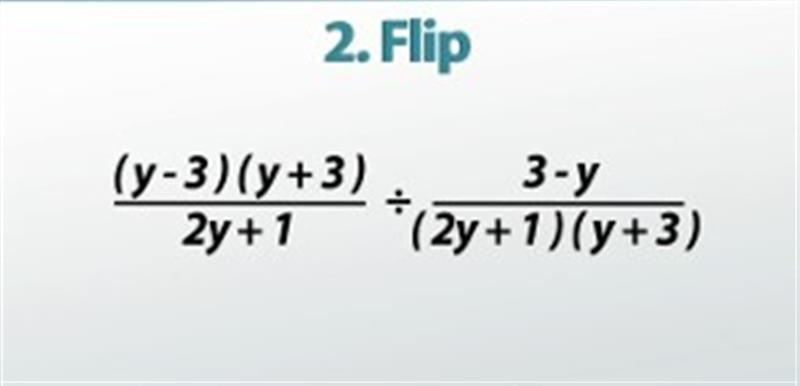Review
Multiplication and division of rational polynomial expressions is easy once you remember the steps.
For multiplication: factor, cancel or slash, and multiply.
For division: factor, flip, cancel or slash, and multiply.
Let's do some larger problems.
Example #1
In example #1, cancel out the like terms to find the solution
((q^2 - 11q + 24) / (q^2 - 18q + 80)) ×((q^2 - 15q + 50) / (q^2 - 9q + 20))
First, we need to factor. (q^2 - 11q + 24) factors into (q - 8)(q - 3). (q^2 - 18q + 80) factors into (q - 10)(q - 8). (q^2 - 15q + 50) factors into (q - 10)(q - 5). (q^2 - 9q + 20) factors into (q - 5)(q - 4).
So, this is what our new expression is going to look like: ((q - 8)(q - 3) / (q - 10)(q - 8)) * ((q - 10)(q - 5) / (q - 5)(q - 4))
Next, we are going to cancel (what I like to call slash) like terms. We're going to cancel or slash (q - 10) over (q - 10), (q - 8) over (q - 8), and finally (q - 5) over (q - 5).
Now that we have canceled or slashed all of the like terms from the top and bottom, we multiply straight across. Don't multiply anything we slashed because those are now 1's. It turns out, our answer is (q - 3) / (q - 4).
Example #2
kkk

In example #2, flip the second fraction before changing the problem to a multiplication one
((y^2 - 9) / (2y + 1)) / ((3 - y) / (2y^2 + 7y + 3))
Let's factor. (y - 9) = (y - 3)(y + 3) and (2y^2 + 7y + 3) = (2y + 1)(y + 3). Our next step is to flip the second fraction and change it to multiplication. Our new expression is going to look like this: ((y - 3)(y + 3) / (2y+ 1)) ×((2y + 1)(y + 3) / ((3 - y)).
The next step is canceling, or what we've been calling slashing. We can slash (2y + 1) over (2y + 1). In the numerator, we have (y - 3)(y + 3) and (y + 3). In the denominator we have (3 - y). If we multiply (3 - y) by -1, we'll get -1(y - 3). Guess what? We can cancel (y- 3) over (y - 3), but remember to leave the -1!
So, our final answer's going to look like: (y + 3)(y + 3) / -1.
But hold on a second! Let's multiply the top and the bottom by -1. This is going to give us -1(y + 3) (y + 3) / 1. When we FOIL, we're going to end up with an answer of -1(y^2 + 6y + 9) / 1. Well if we distribute the -1, we end up with (-y^2 - 6y - 9)!